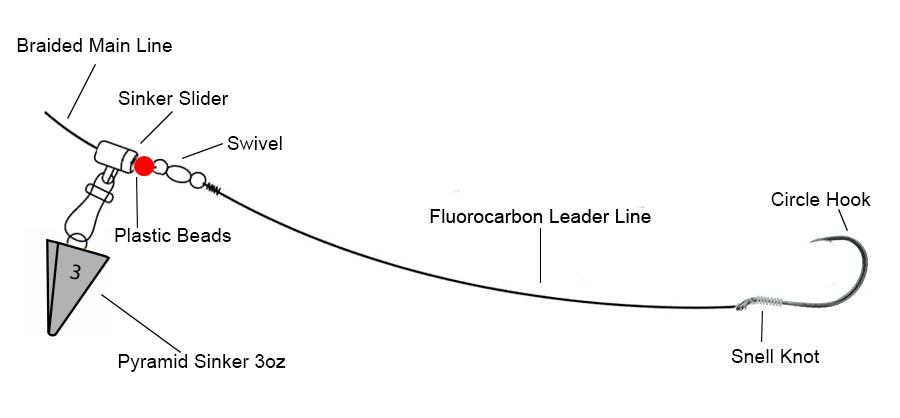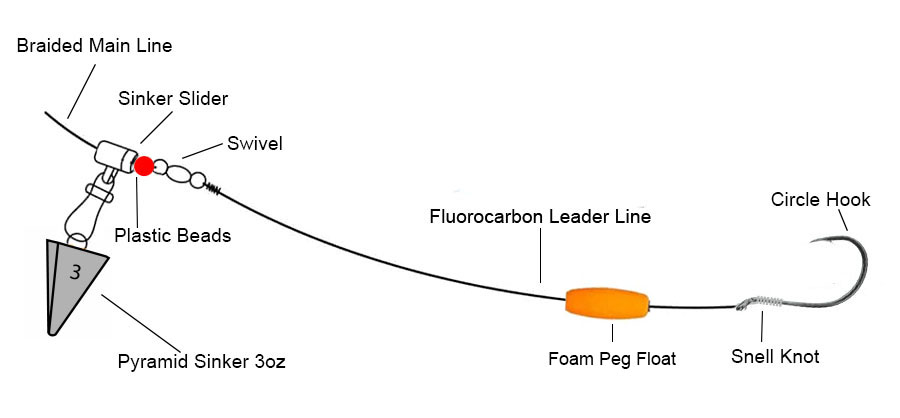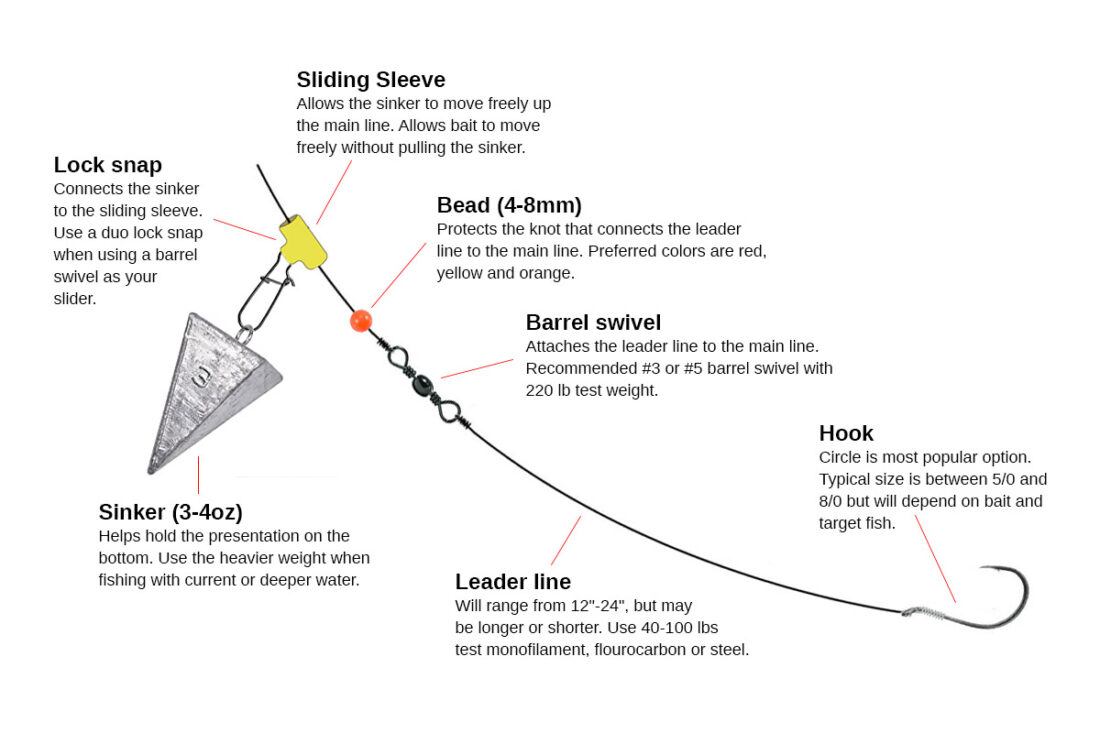The fish finder rig is an ideal fishing rig for surf casting and still fishing. The design of the fish finder rig allows it to excel in challenging conditions such as the big waves and high winds just off the surf.
The fish finder rig is easy to create and works well for catching a variety of fish, such as sea trout, bluefish, red drum, flounder, striped bass, and snook. While one of the most popular fishing rigs, the fish finder is not ideal for all situations. The following are the advantages and disadvantages of the fish finder rig.
| Advantages | Disadvantages |
|---|---|
|
|
- How the Fish Finder Rig Works
- Fish Finder Rig Setup and Supplies
- Pegging a Float
- Baiting the Fish Finder Rig
- Steps for Creating the Fish Finder Rig
- Surf Fishing with the Fish Finder Rig
How the Fish Finder Rig Works
The secret to the fish finder rig is the heavy pyramid sinker attached up the line (18″) from the hook. The sinker rests on sea floor holding the hook and the line near the bottom.
The pyramid weight allows the leader to easily move around so the baited hook floats in the current while bouncing up and down. This makes the bait appear as if it is alive, helping it to attract at bite.
The sinker will slowly move as it is pulled by the current. As it moves, it will kick up small clouds of sand giving the appearance of an injured baitfish near your presentation.
The pyramid sinker is attached to the main line by a sinker slide (size 5). When a fish takes the bait the line slides freely without moving the sinker. This provides a natural experience entincing the the fish to take the bait and allowing the hook to set.
The fish finder rig is also ideal for long casts allowing for proper bait placement and getting your presentation beyond the breaking surf.
The following diagram shows a basic fish finder rig setup.

Fish Finder Rig Setup and Supplies
The fish finder rig is composed of a circle hook attached a leader line, which in turn is attached to the main line using a swivel. Directly above the swivel their is a plastic red bead followed by a pyramid sinker afixed to the main line by a sinker slider.
The basic supplies required for the fish finder rig are shown in the following table.
| Supply | Description |
|---|---|
| Hook | A circle hook is the most popular option for the fish finder rig. Hook size will depend on the target game fish species but will typically range between 5/0 and 8/0. |
| Leader line | Generally, the leader line will range from 12"-24"(1-2ft), but it may be longer or shorter. Larger predatory fish, such as sharks, may require a 36"-48" (3-4ft) leader. Shorter leaders work well for casting long distance and fighting strong currents. Longer leaders work well in clear water where you want to avoid presenting your sinker. The leader should be about 40-100 lb test and can be made of monofilament, flourocarbon or steel depending on the target fish species and conditions. Stronger leader is required for sharks and abrasive environments. |
| Barrel swivel | The barrel swivel attaches the leader line to the mainline. It also prevents the bead and sinker from sliding down to the hook. Recommended swivel sizes are #3 and #5. We also recommend a swivel with a 220 lb test weight to ensure it doesn't snap when casting or retreiving. |
| Lock snap (duo) | Typically you'll use a plastic sliding sleeve to attach the sinker to the main line. However, a barrel swivel may be used in place of a plastic sleeve as the sinker slide. When using a barrel swivel as your slider, a duo lock snap with a snap rating of 150+ lbs will be needed to attach the sinker to the barrel swivel. |
| Bead | The bead protects the knot that connects the leader line to the main line, as well as from the sinker slide or sliding barrel swivel. Secondarily, it prevents the sinker from moving down the line toward the hook. Colorful beads may also attract fish. Preferred bead colors are red, yellow and orange. Recommended bead size is 4-8mm, with 8mm being the most popular size. Beads can be purchased that produce a clicking sound to help attract fish. |
| Sinker (weight) | The sinker, or casting weight, helps hold the presentation on the bottom and resist current. The most popular weight size is 3-4oz. The fish finder rig traditionally uses a pyramid sinker but an egg-shaped sinker will also work. When using an egg shaped sinker, a plastic sleeve is not required. |
| Sliding sleeve (sinker slider) | The plastic sliding sleeve allows the sinker to move freely up the main line. It also allows the bait to move freely without pulling the sinker. This creates a natural presentation that allows the fish to work the bait without resistence. When surf fishing, make sure to purchase a high quality sinker slide that will not break. |
The fish finder rig can be adapted and modified for specific fish species. The following table provides recommended setups for different size game fish species.
| Fish species | Rig setup |
|---|---|
| Red Drum, Bluefish, Snook, Sea Trout, Croaker, Sheepshead, Striped Bass, Flounder, etc. in the 20-40" range | 5/0 Circle Hook, 18" Steel (or Flourocarbon) Leader #40lb., 8mm diameter Plastic Red Bead, Size 5 Sinker Slider, 3oz Pyramid Sinker |
| Small Sharks | 5/0 Circle Hook, 36" Steel Leader #40lb., 8mm diameter Plastic Red Bead, Size 5 Sinker Slider, 3oz Pyramid Sinker |
| Red Drum, Bull Drum, Striped Bass, White Sea Bass, Snook, Tarpon, Cobia, Halibut, etc. above 40"+ | 8/0 Circle Hook, 36″ Steel Leader #80 Lb., 8mm diameter Plastic Red Bead, Size 6 Sinker Slide, 6 Oz. Pyramid Sinker |
Pegging a Float
To keep your bait off the sea floor and protect it from bottom feeding crabs and crustaceans a foam peg float can be attached to the leader just a few inches above the the hook to add bouyancy. I recommend only adding a peg float when the fishing is really good as it can scare off finicky feeders like Snook. Less picky feeders, such as shark, bull drum, bluefish and stripers, will not be bothered by the addition of a peg float to your leader.

Baiting the Fish Finder Rig
When surf fishing or still fishing in saltwater, the fish finder rig is almost always fished using cut bait. Live bait can work with the fish finder rig but dead cut bait is more practical, and far more popular. Using cut bait maximizes scent by releasing the natural oils of the baitfish into the current.
Common cut bait include fresh mullet, mackerel, bunker, herring, and croaker. Sardines may also work. Pieces of clams, mussels, squid and shrimp can also be effectie depending on the target game fish. When using live bait, sand flease, shrimp, bloodworms, sandworms, grunion, crabs and sardines are popular choices.
Steps for Creating the Fish Finder Rig
To create the fish finder, simply take a hook and attach it to a leader. Once that is complete, tie the other end of the leader to a barrel swivel. Then, place a bead and a sliding sleeve (sinker slider) on the main line above the barrel swivel. Finally, add a pyramid sinker to the lock snap.
Step 1 – Attach your hook to your leader line using a snell knot.
Step 2 – Attach the other end of the leader line to a barrel swivel.
Step 3 – Place a sliding lock snap or plastic sleeve (sinker slider) on the main line.
Step 4 – Attach a bead to the main line below the plastic sleeve and above the barrel swivel.
Step 5 – Attach the main line to the barrel swivel.
Step 6 – Attach the pyramid sinker (or egg-shaped sinker) to the lock snap or plastic sliding sleeve.
Surf Fishing with the Fish Finder Rig
- Don’t hold your rod too close to your body. Hold near the bottom of the rod with one hand, with the other hand hold near the real. Extend your arms straight up with your rod butt pointing slightly toward the sky. Look out at the water and up 45 degrees. Now cast. This form will maximize casting distance and accuracy.
- Tighten the drag on your reel until the line is taut. You don’t want your line loose when casting. Having loose line when casting can potentially cut a finger.
- For easier casting attach a casting cannon to your surf rod. (Attach using zip ties.) When ready to cast, push the trigger out, wrap your fishing line around the metal pin two times, then pull the trigger in. This will clamp the line tight. Now cast out and release the trigger to release the line.
- If you’re fishing close to shore for fish found near the break line, such as flatfish, use a longer 24″-30″ leader. This will provide your bait a natural presentation that will entice a bite.
- When casting your rig further from shore much beyond the breakline use a shorter 6″-24″ leader. Using a shorter leader will prevent the rig from helicoptering and increase casting distance.
- Increasing the distance between the tip of your surf rod and weight will have a similar effect as shortening the leader. You’ll be able to cast longer distance without your rig helicoptering.
- For more aggressive predatory fish such as bluefish or shark, we recommend using a steel leader to prevent your line from snapping. A longer leader line is typically used when targeting larger predatory fish.
- When surf fishing, use a minimum 4 oz weight with your fish finder rig. This will ensure you have enough weight for a solid cast and keep your rig in place once it’s on the bottom.
- When using a longer leader line, a bait clip can be used to streamline your rig. The bait clip will allow you to cast extra distance and helps keep your bait intact on a powerful cast.
- While surf fishing with the fish finder rig, target areas with breaking surf where the wave crests are whiter. The water here is going to be shallower and you’ll likely find flatfish, halibut, striped bass and redfish.
- Target areas along the shore with breaking surf, but without large waves and little chance of underwater structure, including rocks, corals and grass.
- After your rig is cast, just wait.
- Check your rod(s) regularly for a bite. Check your bait every 20-30 minutes.




